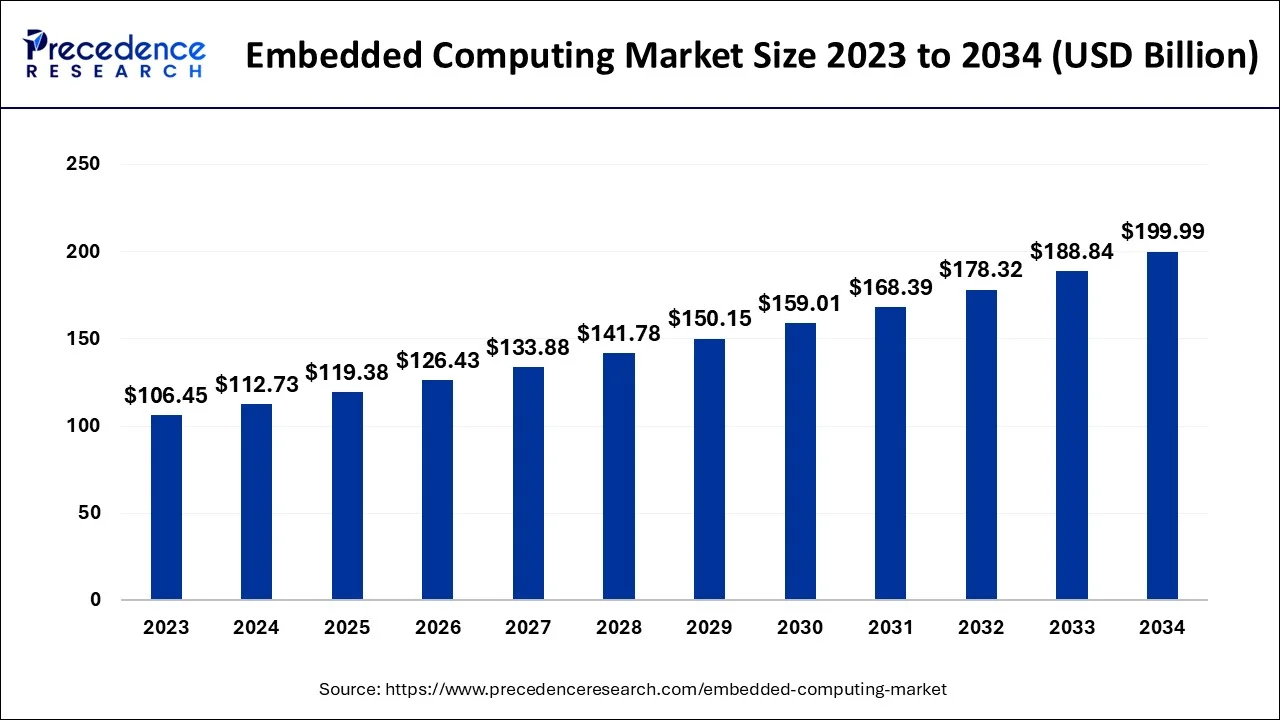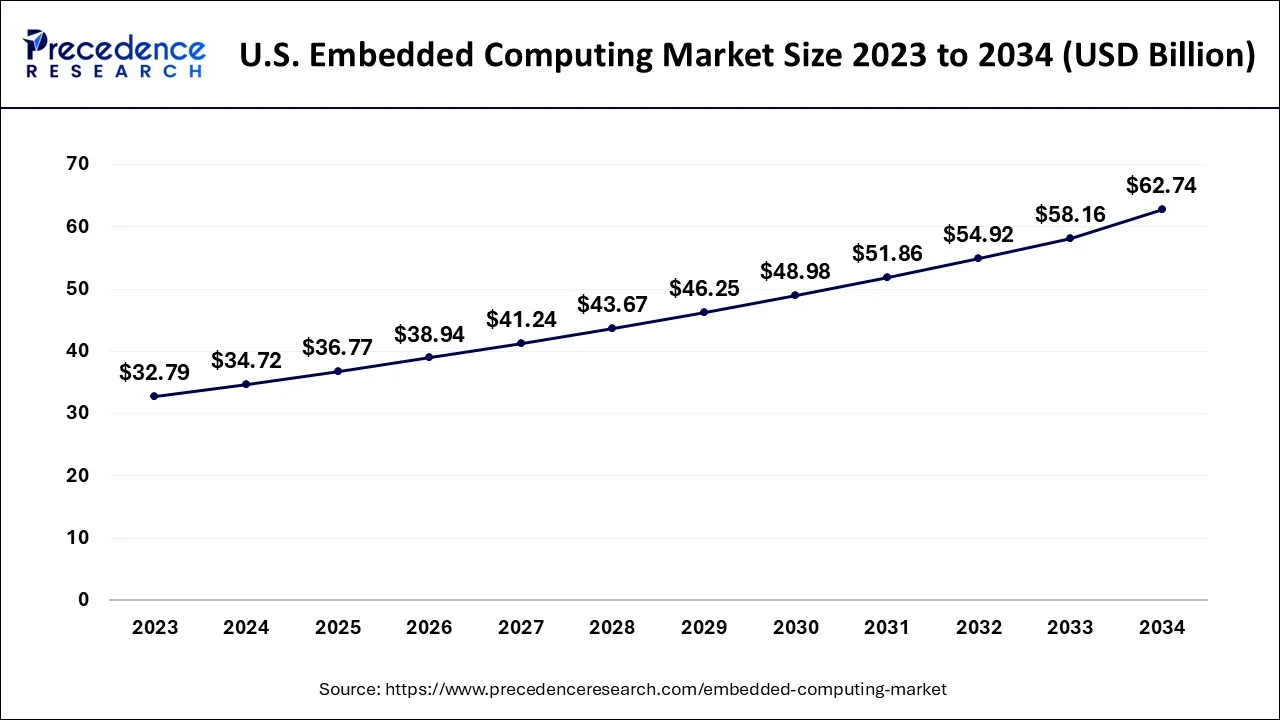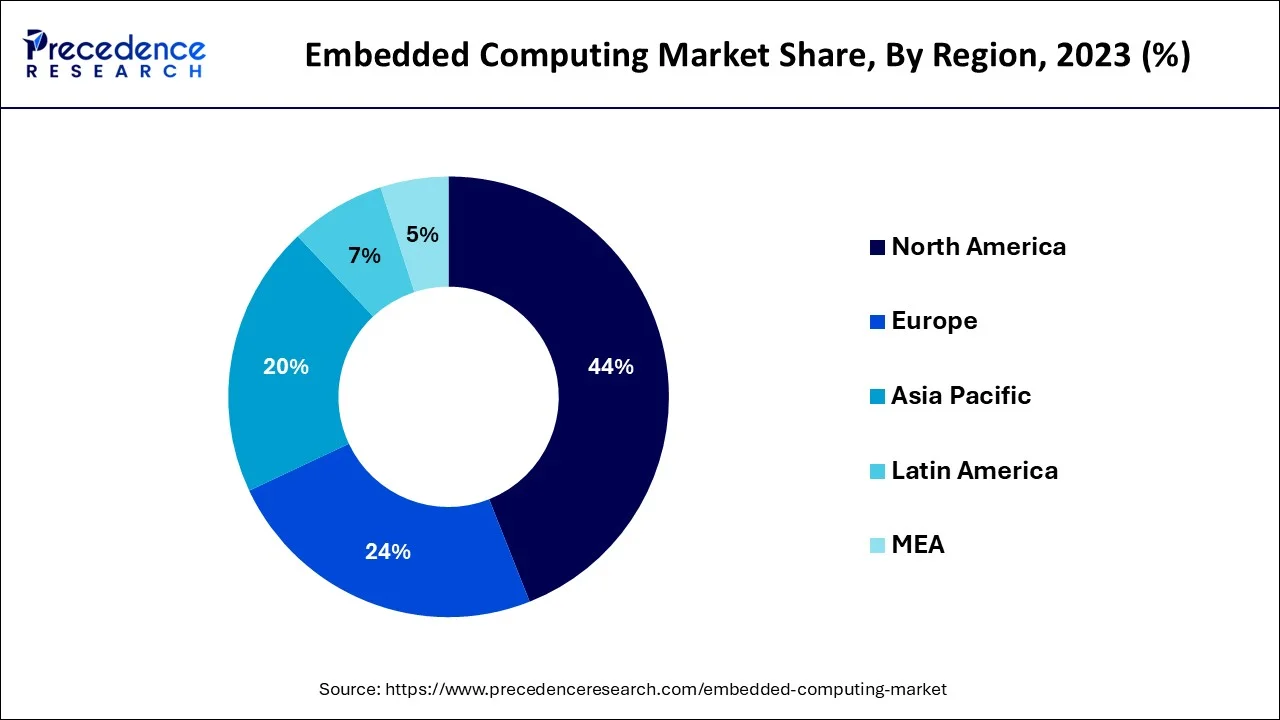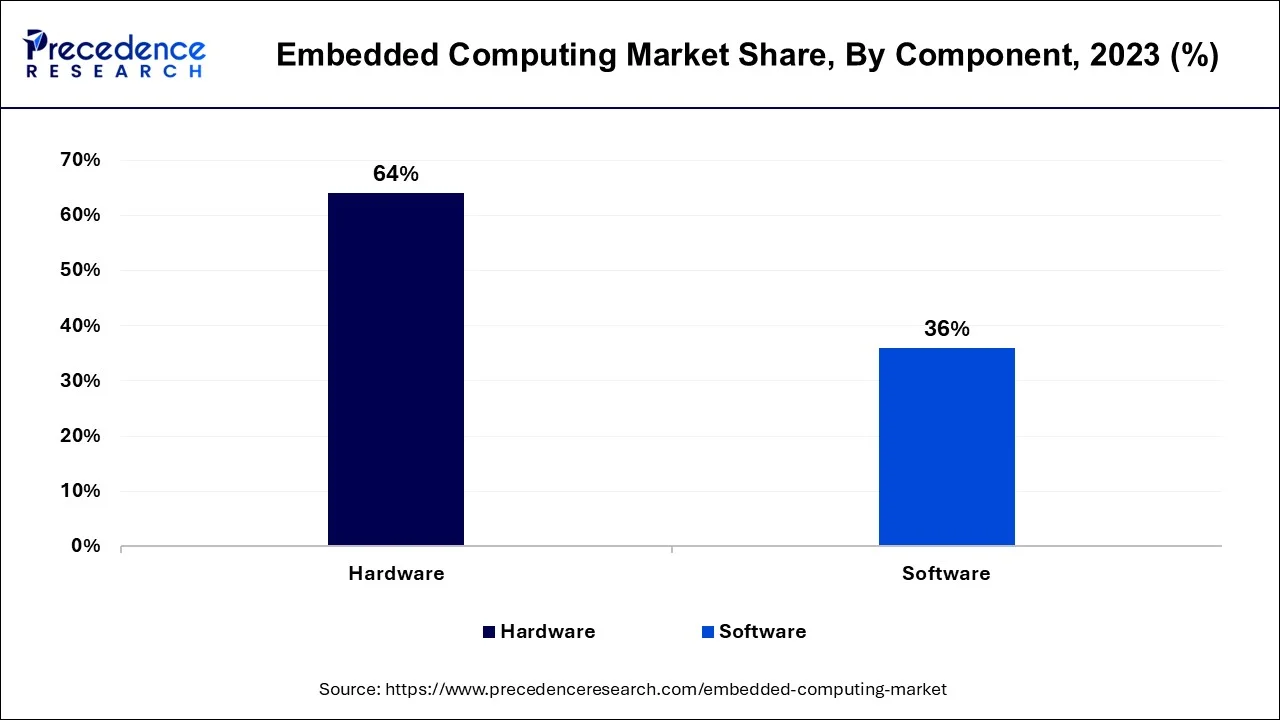February 2025
The global embedded computing market size accounted for USD 112.73 billion in 2024, grew to USD 119.38 billion in 2025 and is predicted to surpass around USD 199.99 billion by 2034, representing a healthy CAGR of 5.90% between 2024 and 2034. The North America embedded computing market size is calculated at USD 49.60 billion in 2024 and is expected to grow at a fastest CAGR of 6.01% during the forecast year.
The global embedded computing market size is estimated at USD 112.73 billion in 2024 and is anticipated to reach around USD 199.99 billion by 2034, expanding at a CAGR of 5.90% from 2024 to 2034.

The U.S. embedded computing market size is evaluated at USD 34.72 billion in 2024 and is predicted to be worth around USD 62.74 billion by 2034, rising at a CAGR of 6.08% from 2024 to 2034.

The highest market share and dominant position in the embedded computing industry belongs to North America. The strong rate of technological adoption and the existence of significant providers in North America are related. Demand for embedded computers is also rising as a result of the expanding IoT applications and robotics businesses in the area. Additionally, a robot-housed embedded system connects all of the different components. Robots would be reliant on external computing systems without an embedded system, raising the risk of communication glitches and delays between the robot and its external control system.

Asia-Pacific is considered as one of the leading regions in the embedded computing market. This region includes China, Japan, India, and rest of the world. During the forecast period, the market in Asia Pacific is anticipated to grow at a significant CAGR. Rising per capita income and continuous, extensive urbanization and industrialization are reasons that are driving Asia Pacific's embedded computer industry forward. Additionally, it is anticipated that the availability of inexpensive electronic goods in Asia and the Pacific will increase demand for microprocessors and microcontrollers in the region. High demand for embedded system hardware, such as microprocessors and controllers, is anticipated in Asia Pacific due to the growing use of autonomous robots and embedded vision systems in industrial applications. Throughout turn, this raises demand in Asia Pacific during the subsequent years.
Embedded systems are task-specific, which means they are created to carry out a single task as opposed to a number of tasks. Although an embedded system's precise design is dependent on the task for which it is intended, most embedded systems have a CPU, a power source, memory, and communication ports. The use of embedded systems has numerous advantages. For instance, they are very adaptable and inexpensive, making it simple and affordable to customize them to precise functional and performance needs. Additionally, they use little power, which lowers the system's overall energy expenditures. It carries out tasks like processing data, reading sensor inputs, displaying necessary output, producing & delivering commands, and transforming data. The consumer electronics, personal care, healthcare, banking, telecommunications, automotive, security, office automation, home applications, and smart card industries are just a few of the industries where it is extensively used.
The surge in consumer electronics use and the increased use of artificial intelligence in a number of applications around the world have boosted the market for embedded computing. The development of technology in the healthcare and industrial sectors, as well as the rise in demand for automated processes in the automotive and smart home appliance industries, are other factors that influence the global embedded computing market.
In the automotive sector, embedded systems are essential. These systems are utilized by the ADAS technology found in hybrid and electric automobiles. The market for embedded computers has expanded as a result of the rise in demand for electric and hybrid vehicles brought on by public awareness of the environment's declining condition. This increases the need for the hardware and software utilized in embedded systems in EVs. The advancement of computer technologies has increased their integration into electronic systems. The embedded system provides a number of applications for electronics systems. A few examples of embedded system applications are cars, smart homes, office automation, and home appliances. Other businesses are now employing embedded systems, such as the military, the defense industry, and the healthcare sector. Rising R&D spending in areas including the automotive, medical, aerospace, and electronics is opening up opportunities for market participants. The global market is driven by product innovation and changing dynamics in developing countries.
The primary driver propelling the market's expansion is the increasing demand for and adaptation of electronic consumer goods and industrial gadgets. The use of embedded computing technology in the healthcare, automotive, artificial intelligence (AI), and many other industries is another driver fueling the growth of the market for performing research in medical science. In the healthcare sector, embedded computing is employed in surgery and treatment tools, patient monitoring systems, and diagnostic and imaging equipment. They are utilized in equipment and systems employed in the life sciences sector for bioinformatics, proteomics, and genome sequencing.
| Report Coverage | Details |
| Market Size in 2024 | USD 112.73 Billion |
| Market Size by 2034 | USD 199.99 Billion |
| Growth Rate from 2024 to 2034 | CAGR of 5.90% |
| Base Year | 2023 |
| Forecast Period | 2024 to 2034 |
| Segments Covered | Component, Application, Geography |
Depending upon the component, the hardware segment hit largest revenue share in 2023. The growth is related to rising living standards, a greater public understanding of technology, and an increase in the country's disposable income. Additionally, as a result of their technological developments, increased understanding, and reasonably priced consumer electronics. People are inclined towards technology hence, the demand for embedded systems is increasing with time.

In addition, due to their advancements, increased awareness of technologies, and affordable consumer electronics, Asia-Pacific and LAMEA are anticipating a potential expansion in the hardware market throughout the projection period. These elements provide the hardware sector substantial growth potential.
Due to expanding industrial development activities, embedded computing is becoming more and more widespread worldwide, but especially in emerging nations. The significant reforms implemented by various governments in their individual countries are blamed for the growth of the embedded computer sector. The usage of embedded computers has also increased due to the expansion of industrial operations because they save time and aid in the automation of machines. In the near future, rising industrial development activities in emerging economies are expected to fuel the market.
During the projected period, the communication segment is anticipated to be the largest in the embedded computing market. The communication sector segment heavily relies on embedded computer systems as a result of population increase and the development of the Internet of Things (IoT). The rise in popularity of consumer electronics goods including mobile phones, laptops, tablets, personal computers, satellites, televisions, and radar as well as the drop in their prices contributed to the expansion of embedded computing in the communication business. Consumers are adopting new devices at high rate which encourages the sales of embedded computing devices in the market.
The section of the automotive industry is anticipated to grow at the fastest rate in the future years. This is a result of the fast rising deployment of sophisticated embedded systems. For various functions including audio systems, security, and ignition, automakers install embedded computing systems in their vehicles. The development of vehicles that are more network-savvy, safe, and energy-efficient is another area where major automakers are likely to engage in technology innovation, which is expected to create profitable growth prospects for the automotive industry.
During the projection period, the healthcare segment is expected to increase significantly. The market is expanding since embedded systems are increasingly being used in healthcare devices like imaging, CT, MRI, and vital sign monitors. A smaller operating system called an embedded system is made to carry out one or two particular functions. Data storage with embedded systems is common in the healthcare industry. It is typically required for OEMs to select industrial grade embedded systems since healthcare applications may be employed in harsh operating environments with temperature variations, exposure to shock and vibration, and more. Industrial-grade items are built to resist those difficult circumstances without losing any functionality. In addition, doctors can use telemedicine and other remote systems to diagnose patients, monitor their health remotely, and decide on a course of treatment helping to embedded systems used in biomedical applications. It is anticipated that there would be a rise in the need for industrial embedded computer systems, which will speed up market expansion. The availability of advanced patient monitoring solutions with improved embedded computing systems has also been made possible by a rise in awareness regarding the deployment of cutting-edge technology for better patient care.
Process control and industrial automation markets are significant end consumers of motherboards and other electronic components like microcontrollers, microprocessors, and graphics cards and have shown to be quite reliable in terms of embedded computer design and development. Industrial automation calls for robust designs that can withstand hostile conditions, high performance, maximum power efficiency, a wide range of I/O, and communication interfaces.
By Component
By Application
By Geography
For inquiries regarding discounts, bulk purchases, or customization requests, please contact us at sales@precedenceresearch.com
No cookie-cutter, only authentic analysis – take the 1st step to become a Precedence Research client
February 2025
January 2025
August 2024
January 2025